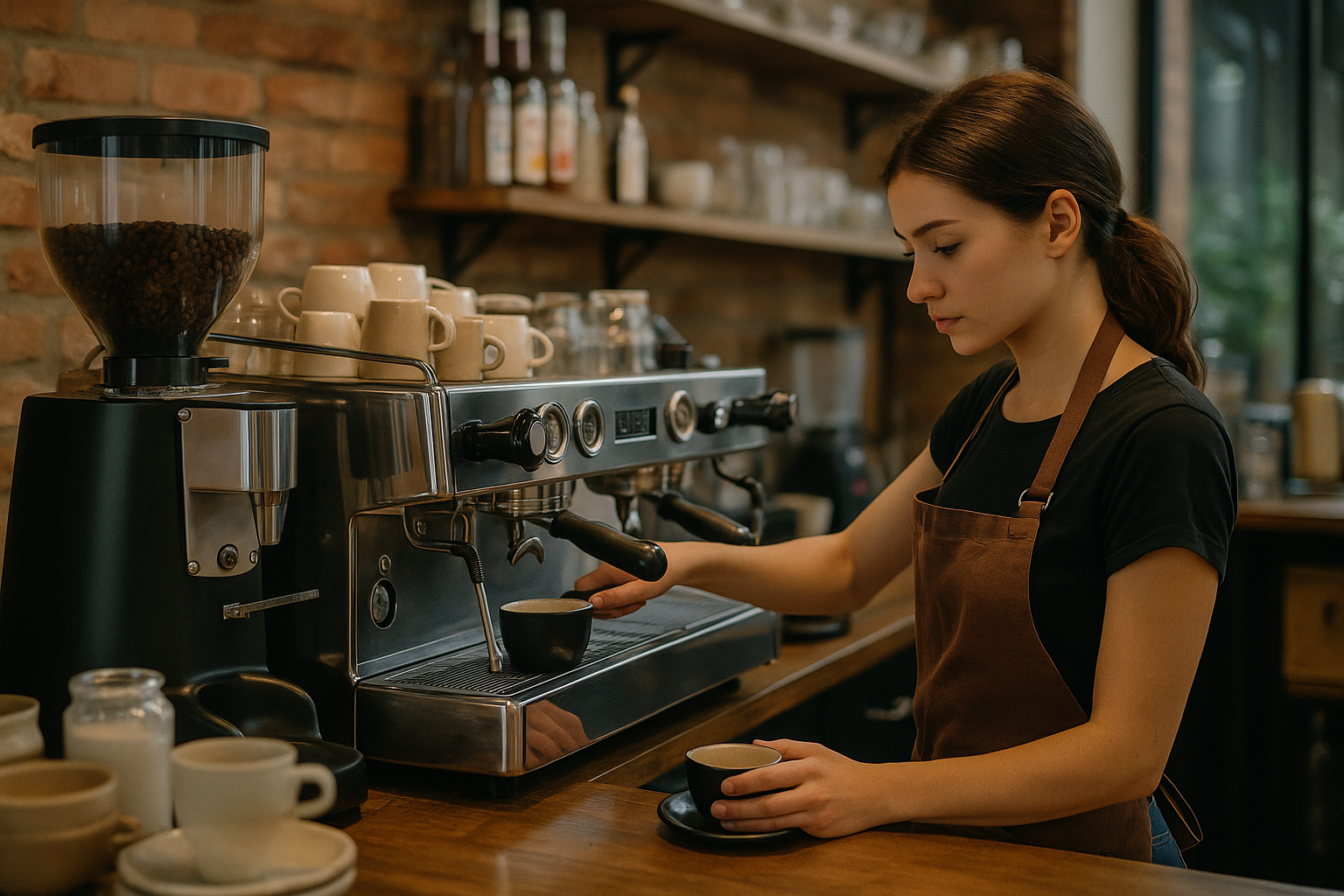If you’ve ever watched a barista in action during a busy morning shift, you might think their job is just about making coffee. But behind every perfect latte is a routine, a rhythm, and a system that keeps things moving.
In this guide, we’ll walk through a typical day in the life of a professional barista, from early mornings to closing duties. Whether you dream of working in a café or simply want to understand the real pace of the job, this will give you a clear, realistic picture.
The Opening Shift: Early Starts and Setup
Most cafés open between 6:00 AM and 8:00 AM — which means baristas often arrive 30 to 60 minutes earlier. Opening the café is more than turning on the lights.
Common opening tasks:
- Powering on the espresso machine to heat up
- Calibrating the grinder and espresso recipes
- Restocking milk, syrups, cups, and utensils
- Brewing the first batch of drip coffee
- Cleaning any equipment left from the night before
- Preparing pastries or food displays
- Reviewing the day’s specials or shift notes
Opening shifts are about setting the tone — a calm and clean bar helps everyone perform better during the rush.
Dialing in the Espresso
“Dialing in” is one of the most important tasks of the morning. It means adjusting the grinder to achieve the best espresso shot possible, based on the coffee being used that day.
Baristas pull test shots, taste them, and adjust grind size, dose, or time until the flavor is balanced. This may take 2–5 shots and some patience.
Even a small change in humidity or bean age can affect taste — so this step requires focus and sensory awareness.
The Morning Rush
By 7:30 or 8:00 AM, most cafés are in full swing. Commuters stop in, regulars order their usual drinks, and mobile orders come in all at once.
During the rush, baristas must:
- Prepare drinks quickly and accurately
- Communicate with coworkers clearly
- Handle multitasking under pressure
- Maintain a positive attitude with every customer
- Keep the workspace clean and stocked
It’s intense — but also rewarding. Many baristas say the rhythm of the morning rush is where they feel most “in the zone.”
Speed matters, but consistency matters more.
Breaks and Resetting
After the initial rush, things calm down. Baristas take short breaks (usually 10–15 minutes), grab food, or rotate stations.
This slower window is ideal for:
- Deep cleaning the espresso machine
- Recalibrating if shots are inconsistent
- Refilling inventory
- Prepping for the lunch shift
- Checking emails or restocking pastries
Staying organized during quiet periods is crucial. It prepares the team for the next wave and prevents last-minute panic.
Midday Flow
Between 11:00 AM and 2:00 PM, cafés may get another rush — especially if they serve food or are near offices and schools.
Here, orders become more varied:
- Iced drinks
- Decaf requests
- Specialty lattes
- Alternative milks
- Sandwiches or baked goods
Customer questions also increase. Baristas may need to explain the menu, suggest drinks, or share the origin of a featured coffee.
Side Duties and Teamwork
Every barista also has secondary responsibilities that rotate during the day.
These may include:
- Washing dishes
- Organizing storage
- Restocking syrups or tea
- Taking out trash and recycling
- Training a new staff member
- Updating the menu board
Café work is collaborative. Everyone supports each other to keep the shift flowing.
Engaging with Customers
Good baristas aren’t just drink makers — they’re also hosts.
During quieter hours, they might:
- Chat with regulars
- Offer samples of a new roast
- Ask for feedback
- Explain the tasting notes of the espresso being used
The best baristas help people feel welcome and remembered. That’s what keeps customers coming back.
The Afternoon Slowdown
Between 2:00 PM and 4:00 PM, foot traffic usually slows. This is a time for reflection and maintenance.
Tasks may include:
- Deep cleaning grinders and milk wands
- Preparing cold brew or batch brew for the next day
- Prepping closing inventory reports
- Sanitizing all surfaces
- Testing new drink recipes
Some baristas use this time to practice latte art or improve their pouring speed.
Closing Duties
The closing shift involves wrapping up the entire day. Baristas clean deeply, prepare the café for the next opening shift, and ensure everything is ready for a smooth start tomorrow.
Typical closing tasks:
- Backflushing and rinsing the espresso machine
- Washing and drying pitchers, tampers, and portafilters
- Cleaning the fridge and restocking for the morning
- Emptying trash and compost
- Counting the register or sales
- Sweeping and mopping the floor
- Locking all equipment and doors
The goal is to leave the café in perfect condition — as if the next shift were starting in five minutes.
The Physical and Mental Challenge
A barista’s day is long and physically demanding.
Common challenges:
- Standing for 6–10 hours
- Repetitive movements (tamping, steaming, pouring)
- Fast-paced multitasking
- Dealing with difficult customers
- Staying friendly under pressure
That said, baristas often describe their job as energizing, creative, and social. The fast pace, strong coffee, and great coworkers make the effort worth it.
Building Professional Habits
A typical barista day teaches discipline. The repetition of tasks builds muscle memory and speed. Over time, professionals learn:
- How to prep faster
- How to notice tiny flavor changes
- How to predict busy periods
- How to manage time and priorities
- How to teach new staff effectively
Every shift adds a layer of skill. And the more you pay attention, the more you improve.
Final Thoughts: It’s More Than Just Making Coffee
A barista’s day is full of movement, people, challenges, and small wins. From the first dial-in to the final mop stroke, every part of the shift matters.
It’s not always easy — but it’s rarely boring. You grow fast, learn constantly, and connect with people over something simple yet powerful: a great cup of coffee.

Artur is a coffee enthusiast and content creator passionate about barista techniques and coffee culture. With a sharp eye for detail and a love for learning, he shares practical tips, brewing guides, and gear insights to help readers elevate their coffee experience — from home brewers to aspiring professionals.
